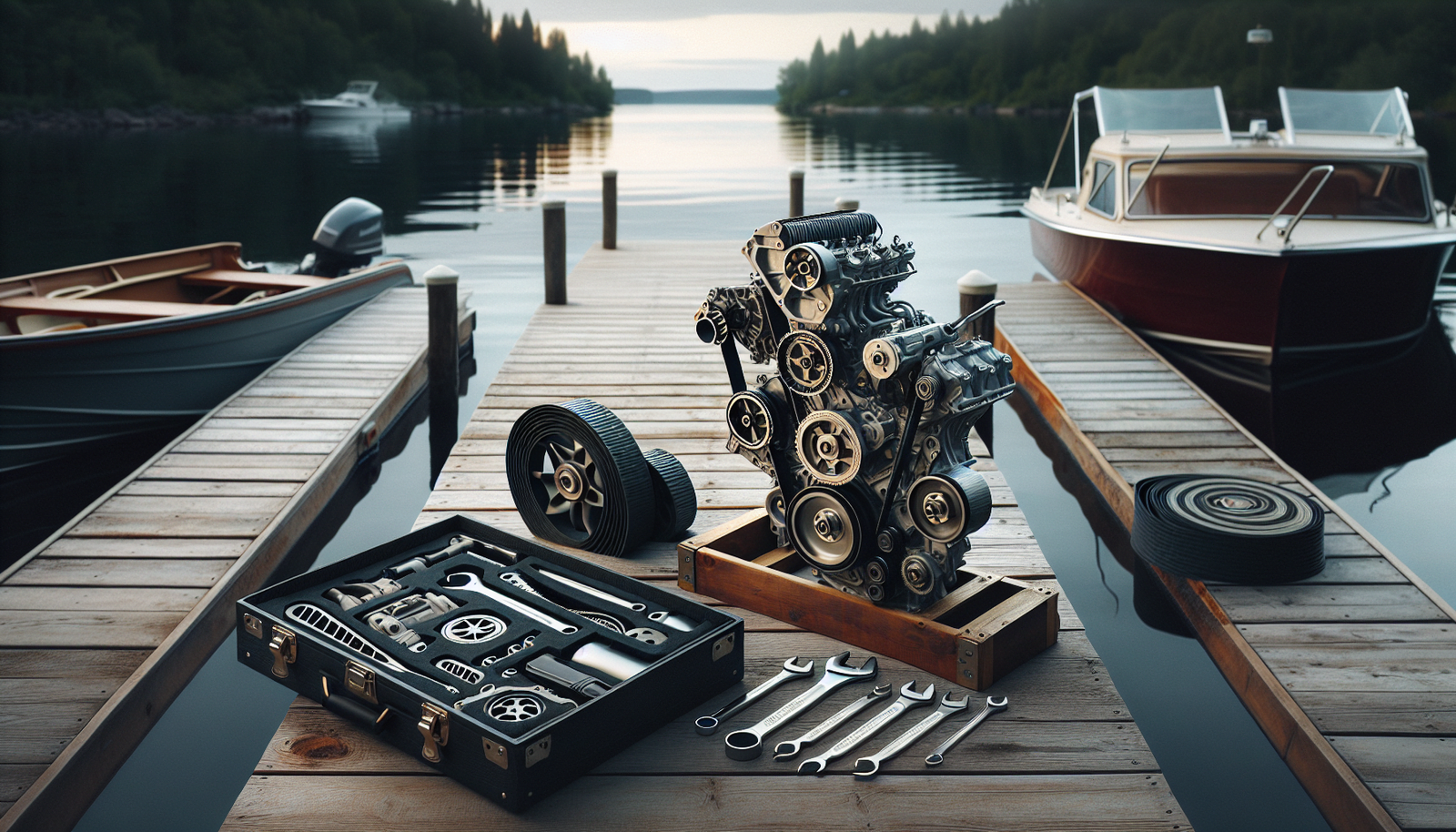In the realm of boating, few things can bring about quite as much unease as the thought of a failing engine while out at sea. It’s no secret that replacing a boat engine belt can prove daunting, but it’s a crucial skill every boat owner should master. In “Expert Guide to Boat Engine Belt Replacement”, you’ll be guided through a detailed and easy-to-follow process that breaks down the intricacies of replacing a boat engine belt. Your fear will be replaced by confidence as you learn how to pinpoint when the belt needs changing and the efficient way to go about it. Nothing could be more gratifying than knowing you’ve taken a proactive step towards ensuring your boat’s optimal performance and safety while cruising across the majestic deep blues.

Understanding The Importance Of Boat Engine Belts
Ever wondered why your boat engine works so smoothly? It’s thanks to the intricate network of components that work together tirelessly, with one of the key components being the engine belts. These belts play a significant role in keeping your boat afloat and moving.
Role Of Boat Engine Belts
Boat engine belts are responsible for transferring power from the engine to various components, such as the alternator, raw water pump, and power steering pump. They take the rotational force from the engine crankshaft and use it to spin these components. Without these belts, your boat can’t generate electricity, steer correctly, or even cool its engine.
Impact Of Worn-Out Or Damaged Engine Belts
Condition of your boat engine belts can make or break your nautical adventures. A worn-out or damaged belt can cause the failure of crucial systems, leading to engine overheating or a dead battery. Your safety could even be at risk if the power steering belt fails in the middle of the sea.
Signs Of Engine Belt Failure
For your boat to run smoothly, it’s important to identify the signs of engine belt failure early. This can include a squealing noise, power steering issues or a malfunctioning alternator. Regular inspection of your engine belts for wear or damage can save you from a potential catastrophe.
Types Of Boat Engine Belts
Like people, not all boat engine belts are created equal. Each belt has a specific role to play in your engine’s smooth operation.
Raw Water Pump Belts
This belt helps keep your engine cool by driving the raw water pump, which circulates sea water through your engine to dissipate heat.
Alternator Belts
This belt transfers power from the engine to the alternator, which in turn charges the battery and powers the boat’s electrical systems.
Power Steering Pump Belts
This belt keeps your steering smooth by powering the hydraulic pump that operates the power steering system.
Understanding Differences And Specifics
Each of these belts has unique features and requirements. It is vital to understand them to ensure proper replacement and maintenance.
Safety Precautions Prior To Boat Engine Belt Replacement
Safety first should be your motto while replacing your boat engine belts.
Wearing Proper Safety Gear
Always wear safety gloves and goggles to protect yourself from unexpected sharp edges and flying debris.
Disconnecting Power Supplies
Remember to disconnect the battery before you start the work. You don’t want to get an electrical shock while working on your boat.
Maintaining A Clean Working Area
Keeping your workspace clean and organized can prevent accidents. It can also make the job quicker by keeping your tools within arm’s reach.
Tools Required For Boat Engine Belt Replacement
Having the right tools can make the process of replacing your boat engine belt a lot easier.
Specific Wrench Sizes
You’ll need wrenches of specific sizes to loosen and tighten the bolts on your boat’s engine.
New Replacement Belt
Of course, you’ll need a new belt to replace the old one. Make sure it’s of the right type and size for your boat’s engine.
Belt Tension Gauge
Using a belt tension gauge can help you accurately adjust the new belt’s tension.
Container For Parts
A container can keep your parts organized and prevent them from getting lost in the process.

Identifying The Correct Replacement Belt
Choosing the right replacement belt is not as simple as it may seem.
Understanding Belt Specifications
First, understand the belt specifications required by your boat’s engine, which can usually be found in the manual.
Shopping For Quality Brands
Not all brands are the same. Reputable brands usually offer higher quality and more durable belts.
Checking Compatibility With Your Boat Engine
Ensure that the belt you’ve chosen is compatible with your boat engine. Using the wrong belt can lead to premature failure or even damage your engine.
Preparation Before Belt Replacement
A little preparation can go a long way in ensuring a smooth belt replacement process.
Clean Surrounding Area
Starting with a clean area can help prevent dirt or debris from getting into the engine.
Remove Any Obstructing Elements
Removing any parts that may obstruct your work can make your task easier.
Ensure Adequate Lighting And Visibility
Good lighting can make the difference between a quick, successful job and a drawn-out, frustrating process. Ensure you can clearly see what you’re doing.
Step By Step Process Of Replacing A Boat Engine Belt
With preparation and tools ready, you’re now set to replace the belt.
Loosening The Old Belt
First, you need to loosen the old belt by adjusting the tensioner.
Removing The Old Belt
After loosening the old belt, you can remove it.
Comparing Old Belt With New Belt Before Installation
Comparing the old belt with the new one ensures that you have the correct replacement.
Installation Of New Belt
Install the new belt on the pulleys, ensuring that it sits properly and doesn’t slip.
Adjusting The New Belt’s Tension
Using a tension gauge, correctly adjust the belt tension according to the manufacturer’s specifications.
Final Checks After Installation
After installation, check the alignment and tension one more time. Make sure there’s no play or slippage in the belt.
Common Mistakes While Replacing Boat Engine Belts
Replacing boat engine belts is simple, but there are common mistakes you should avoid.
Incorrect Belt Size
Using a belt of incorrect size can lead to belt slippage, squealing noise, or premature belt wear.
Over Or Under Tensioning The Belt
Over or under tensioning the belt can cause premature belt failure or wear. Follow the manufacturer’s specifications for the correct tension.
Ignoring Worn-Out Pulleys
Remember to check the condition of your pulleys as well. A worn-out pulley can ruin or damage even a new belt.
Not Regularly Checking Belt Status After Installation
After replacing the belt, perform regular checks to ensure that it’s in good condition and correctly tensioned.
Maintaining New Belt For Longevity
Proper maintenance can extend your new belt’s lifespan and save you from unexpected failures.
Regular Inspections
Regularly inspect your belt for signs of wear, cracks, or damage.
Proper Cleaning Methods
Clean your belt using a soft cloth to remove any dust or debris that can cause wear. Avoid using harsh cleaners or abrasives.
Timely Tension Adjustments
If the belt becomes loose with use, adjust its tension as needed.
Avoiding Belt Strain
Avoid overloading your boat or putting strain on the belt as it can accelerate wear and reduce the belt’s lifespan.
Professional Help For Boat Engine Belt Replacement
If you’re not comfortable doing this by yourself, professional help is always an option.
Recognizing When To Seek Professional Help
If you lack the knowledge or tools, or if the job seems too difficult or risky, it’s a clear sign that you should seek professional help.
Choosing A Trusted Services Provider
Choose a trusted service provider with good customer reviews and a reputation for quality service.
Cost Analysis Of DIY Vs Professional Replacement
Doing it yourself can save you money, but it’s also important to consider the cost of potential errors or damages. Sometimes, professional replacement can be the more cost-effective option in the long run.

